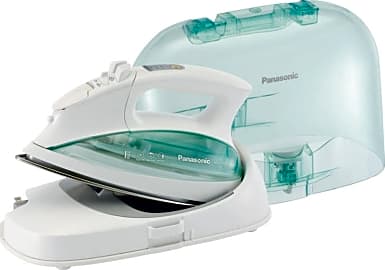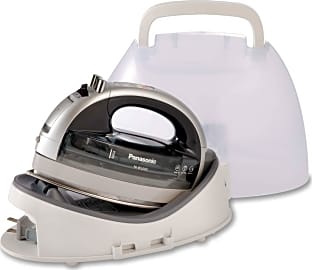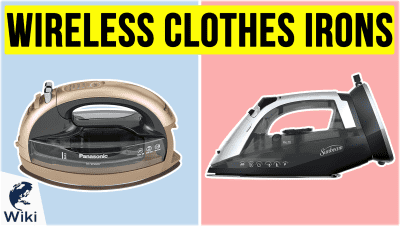The 10 Best Steam Irons For Clothes

This wiki has been updated 42 times since it was first published in February of 2015. Look, we get it: no one enjoys this chore. Still, the irons on this list can take some of the drudgery out of the task, thanks to their ergonomic handles, powerful blasts of steam, and an assortment of other bells and whistles. You'll be able to walk around in crisp, freshly-pressed clothes all the time, without having to spend your entire weekend tethered to your board. When users buy our independently chosen editorial picks, we may earn commissions to help fund the Wiki.
Editor's Notes
March 31, 2021:
Without any groundbreaking ironing innovations to account for in the last little bit, and with none of our previous picks presenting any availability issues or quality concerns, we managed to move through this round of updates without making any major changes. It looks like the last editor for this page did a nice job of putting together a range of options, as is appropriate for a broad category like this one. But, if you already have some specific ideas about the sort of iron you want, then you might prefer to jump over to one of our specialized sets of rankings. We’ve got lists of travel irons, cordless irons and clothes steamers, as well as a separate page for ironing boards.
February 17, 2020:
Even though its design is compact and useful for travelers, the Sunbeam Hot-2-Trot has been known to rust, a frustration that has prompted us to remove it at this time. We've also removed the Singer Expert Finish over concerns about its long-term durability. But when it comes to top names, the Maytag M400 and the Panasonic Contoured are still good choices. They put a range of features at your fingertips, including intuitive controls. The latter is a wireless clothes iron that even has a detachable tank, which means fewer hassles when it's time to refill. There's also the Black & Decker D3030 Allure, which will turn off automatically when left on its side for 30 seconds; for those prone to accidents, this is definitely a good thing. While none of these are overly expensive, we've also opted to add a budget-friendly model, the Shark Lightweight. It isn't as robustly leak-proof as some of the pricier models, but it offers 1,500 watts and an 8.5-inch soleplate you can count on.
Special Honors
Laurastar Smart U The Laurastar Smart U is definitely an intelligent model, since it will connect to your smartphone via Bluetooth and offer video tutorials that can actually make you better at ironing. Plus, the steam it emits can help eliminate bacteria while giving you crisply pressed clothing. laurastar.com.au
Oliso TG1100 If you've ever accidentally burned right through a fabric, you should be able to appreciate the "Scorchguard" technology found on the Oliso TG1100. The integrated lifters actually remove the iron from the garment once you've stopped ironing, so there's no risk of the soleplate accidentally resting on the fabric for too long. oliso.com
Miele FashionMaster Built for versatility, the Miele FashionMaster is a robust system with a separate handheld steamer to complement the sturdy iron, which is also capable of producing steam. Pneumatic springs lift and lower the table in a flash, and you can work easily from a seated position thanks to the handy foot switch. mieleusa.com
How A Steam Iron Works
They differ from dry irons, which don’t distribute steam and instead are meant for fabric that is ideally already damp.
Steam irons use heat, steam, and force to stretch out the molecules in a fabric and remove wrinkles. They differ from dry irons, which don’t distribute steam and instead are meant for fabric that is ideally already damp. Depending on the toughness of the material, and the severity of the wrinkles, one can apply more or less steam as needed. The weight of the iron along with the user's applied pressure work in sync with the produced steam, to smooth out the material efficiently.
The part of the iron that touches one’s clothing is called the soleplate, and is typically made from aluminum, steel, or ceramic. The plate also gets pre-treated with a water resistant substance to prevent rusting and oxidization. Soleplates in steam irons are crafted with small pores to ensure a uniform diffusion of water.
Water sits inside of a tank within the iron, and when it’s released through the soleplate, it immediately evaporates into steam. Most steam irons have built-in thermostats so users don’t need to select a temperature. Instead, they can choose a type of fabric on a dial or screen. The iron will set itself to the proper corresponding temperature, and beep or display a blinking light when the water inside has reached it.
Steam irons have power cords that are heat insulated in order to prevent electrocution, and that often contain a spring in order to direct the part of the cord closest to the metal plate away from it. This prevents the exterior of the cord from overheating and potentially burning the user’s hand or causing electrical failure.
Special Features To Look For
People who travel frequently for work and need to look presentable after long flights, with no time to stop at a hotel, can benefit from a portable steam iron. These are usually cordless, instead running on batteries, and are typically small enough to place in a carry-on. Models that heat up quickly are also useful for busy individuals.
For larger steam jobs, one might need an iron with a large water reservoir.
As with all devices that produce heat, safety features are always important in a steam iron. Some models come with carrying cases made of thermally-stable plastics, so the iron can be safely stowed away after use, reducing the chance that someone accidentally touches it while it’s still hot. Retractable cords are convenient and also enhance safety, reducing the chance of someone tripping over an iron's cord as it is splayed out across the ground.
For larger steam jobs, one might need an iron with a large water reservoir. While some tanks only hold 10 ounces or less, larger models can contain over 30 ounces of water, allowing the user to steam several full suits or items made of tough materials without needing to refill. If a person needs this type of steamer, they should consider one that can safely sit on the floor, as these can be very heavy. For precision jobs, one should look for a model that delivers steam at predictable intervals of time, and that disperses it evenly across the entire soleplate.
When creating heat-enforced lines like pleats on trousers, a model with a sharp tip is best. If one works with delicate fabrics with specific temperature requirements, the limited materials listed on some dials won’t suffice and one may need an iron that lets them manually adjust the thermostat. An LCD screen can also be helpful if it tells information like water temperature and gives alerts when the tank needs to be refilled.
The History Of The Hot Iron
People have been combining metal and heat for centuries in order to iron clothing. In first century BCE China, people placed hot coals in metal pans and applied them to fabric. The pans were replaced in the 17th century by slabs of cast iron that were heated over a fire, and this is conceivably where the term flat iron came from. In certain parts of India, coconut shells replaced charcoals because they withstand as much heat and are readily available.
The pans were replaced in the 17th century by slabs of cast iron that were heated over a fire, and this is conceivably where the term flat iron came from.
In the 19th and 20th centuries, many homes had pipes that fed natural gas or carbide gas to appliances such as light fixtures and liquid fuel irons. These peculiar devices resemble more of a cheese grater than an iron, and were sold in the United States until the end of World War II, when it was realized their combustible nature posed a dangerous threat. They were eventually replaced with electrical units, and were controlled by a thermostat that could be turned on and off as needed to maintain the appropriate temperature. The Industrial Age ushered in the use of aluminum and stainless steel on the soleplate, as well as heat resistant plastic coatings.
A man named Thomas Sears created the first steam iron. A New York drying and cleaning company marketed the commercial model in 1926, but they did not make many sales. A Chicago native named Max Skolnik received the first patent for an electric steam iron in 1934 and, in 1938, he sold the rights of his product to Steam-O-Matic Corporation. Skolnik’s model was the first one to have commercial success and led to the popularity of the electrical steam iron.















